|
No
More Miss America! (1968-1969)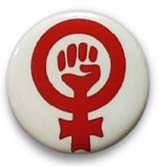
Browse photos of the 1969 Miss America Protest.
 In
1968 and 1969 women's
liberation staged demonstrations at the annual Miss America Beauty
pageant held in Atlantic City, NJ. The 1968 protest shocked the country,
creating a lot of publicity, and some myths, about the new movement. The
1969 protest was smaller and was largely ignored. In
1968 and 1969 women's
liberation staged demonstrations at the annual Miss America Beauty
pageant held in Atlantic City, NJ. The 1968 protest shocked the country,
creating a lot of publicity, and some myths, about the new movement. The
1969 protest was smaller and was largely ignored.
 The 1968 protest originated with New York Radical Women, one of the earliest
women's liberation groups in the country. About 150 feminists from six
cities joined them to show how all women were hurt by beauty competitions.
They argued that the contest declared that the most important thing about
a woman is how she looks by parading women around like cattle to show
off their physical attributes. All women were made to believe they were
inferior because they couldn't measure up to Miss America beauty standards.
Women's liberation would "attack the male chauvinism, commercialization
of beauty, racism and oppression of women symbolized by the Pageant."
The 1968 protest originated with New York Radical Women, one of the earliest
women's liberation groups in the country. About 150 feminists from six
cities joined them to show how all women were hurt by beauty competitions.
They argued that the contest declared that the most important thing about
a woman is how she looks by parading women around like cattle to show
off their physical attributes. All women were made to believe they were
inferior because they couldn't measure up to Miss America beauty standards.
Women's liberation would "attack the male chauvinism, commercialization
of beauty, racism and oppression of women symbolized by the Pageant."
 The Atlanta City convention center opens onto a vast boardwalk between
it and the beach. The large expanse of boards easily seen from the entrance
makes it a great place for demonstrations. Women's liberation took advantage
of this to stage several guerilla theater actions. A live sheep was crowned
Miss America. Objects of female oppression -- high heeled shoes, girdles,
bras, curlers, tweezers -- were tossed into a Freedom Trash Can. A proposal
to burn the can's contents was scuttled when the police said that a fire
would pose a risk to the wooden boardwalk. Women sang songs that parodied
the contest and the idea of selling women's bodies: "Ain't she sweet;
making profits off her meat." A tall, Miss America puppet was auctioned
off.
The Atlanta City convention center opens onto a vast boardwalk between
it and the beach. The large expanse of boards easily seen from the entrance
makes it a great place for demonstrations. Women's liberation took advantage
of this to stage several guerilla theater actions. A live sheep was crowned
Miss America. Objects of female oppression -- high heeled shoes, girdles,
bras, curlers, tweezers -- were tossed into a Freedom Trash Can. A proposal
to burn the can's contents was scuttled when the police said that a fire
would pose a risk to the wooden boardwalk. Women sang songs that parodied
the contest and the idea of selling women's bodies: "Ain't she sweet;
making profits off her meat." A tall, Miss America puppet was auctioned
off.
 Sixteen feminists bought tickets to the evening's entertainment. They
smuggled in a banner reading WOMEN'S LIBERATION. Sitting in the front
row of the balcony, they unfurled it as the outgoing Miss America made
her farewell speech, while shouting "Freedom for Women," and
"No More Miss America." The pageant continued as though nothing
had happened. This action was quickly followed by the release of two stink
bombs on the floor of the hall. All protestors were removed from the hall;
five were arrested, but later released.
Sixteen feminists bought tickets to the evening's entertainment. They
smuggled in a banner reading WOMEN'S LIBERATION. Sitting in the front
row of the balcony, they unfurled it as the outgoing Miss America made
her farewell speech, while shouting "Freedom for Women," and
"No More Miss America." The pageant continued as though nothing
had happened. This action was quickly followed by the release of two stink
bombs on the floor of the hall. All protestors were removed from the hall;
five were arrested, but later released.
 The outrageousness of challenging the Miss America icon brought the press
out in droves, putting women's liberation on the front pages all over
the country. From this, women learned that a new feminist movement was
emerging and flocked to join.
The outrageousness of challenging the Miss America icon brought the press
out in droves, putting women's liberation on the front pages all over
the country. From this, women learned that a new feminist movement was
emerging and flocked to join.
 The 1968 demonstration also saddled women's liberation with the myth of
bra burning. Forevermore the press would repeat that women burned their
bras. They never remembered where this was supposed to have occurred,
let alone that it never happened.
The 1968 demonstration also saddled women's liberation with the myth of
bra burning. Forevermore the press would repeat that women burned their
bras. They never remembered where this was supposed to have occurred,
let alone that it never happened.
 Women's liberation invited even more women to "Don't Miss America"
the next year. They planned more "actions, excitement, analysis,
militance." But very little happened.
Women's liberation invited even more women to "Don't Miss America"
the next year. They planned more "actions, excitement, analysis,
militance." But very little happened.
 In anticipation of disruption, on September 4, 1969 the Pageant got a
court injunction prohibiting actions similar to the ones that took place
in 1968, and some that were merely rumored but had neither been planned
nor had happened. As soon as women's liberation marched onto the boardwalk
the local police read them the riot act -- the injunction -- and threatened
arrest if it was violated. An officer examined the protest signs to see
if any had prohibited "offensive language." Afterwards, the
women were kept on the beach side of police barricades, well away from
the entrance to the hall. They marched and performed skits while members
of the public gawked from the other side of the barricades. Lacking much
else to do, the feminists went up to the women gawkers and engaged them
in conversation about what was going on.
In anticipation of disruption, on September 4, 1969 the Pageant got a
court injunction prohibiting actions similar to the ones that took place
in 1968, and some that were merely rumored but had neither been planned
nor had happened. As soon as women's liberation marched onto the boardwalk
the local police read them the riot act -- the injunction -- and threatened
arrest if it was violated. An officer examined the protest signs to see
if any had prohibited "offensive language." Afterwards, the
women were kept on the beach side of police barricades, well away from
the entrance to the hall. They marched and performed skits while members
of the public gawked from the other side of the barricades. Lacking much
else to do, the feminists went up to the women gawkers and engaged them
in conversation about what was going on.
 The feminist button depicting
a clenched fist inside the biological female symbol debuted at the 1969
protest. It quickly spread to become the women's liberation trademark.
As originally designed, it was "menstrual red" on white, though
it morphed into many colors and styles over the next few decades.
The feminist button depicting
a clenched fist inside the biological female symbol debuted at the 1969
protest. It quickly spread to become the women's liberation trademark.
As originally designed, it was "menstrual red" on white, though
it morphed into many colors and styles over the next few decades.
Photos of the 1969 Miss America
Protest by Jo Freeman
Please click on thumbnails to view the complete image
| Women's
Liberation marches onto the Atlantic City boardwalk.
|
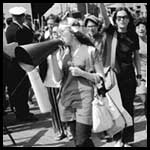
|
|
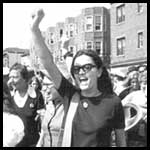 |
|
|
|
|
| |
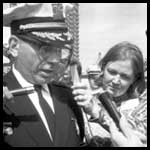
|
|
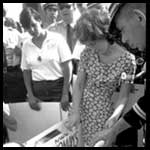 |
| . |
Police read injunction.... |
|
|
|
| . |
...and examine posters for "offensive language." |
|
|
| Marching
on the boardwalk |
 |
|
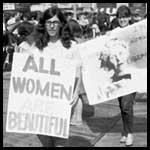 |
| |
|
|
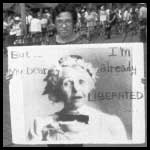
|
|
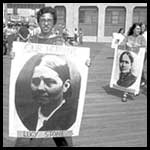 |
| |
|
|
| |
 According
to Terry Moon, who came from Detroit to participate in the demonstration,
the skit depicted the life of a typical American woman college graduate.
She marries, has a child and spends her days cleaning and cooking. After
years of years of tedium, she wants to return to the world and decides
to get a job. According
to Terry Moon, who came from Detroit to participate in the demonstration,
the skit depicted the life of a typical American woman college graduate.
She marries, has a child and spends her days cleaning and cooking. After
years of years of tedium, she wants to return to the world and decides
to get a job.
 The signs describe the reality she faces: "Boring job: Woman wanted,"
"Low Pay: Woman wanted." Then she meets the "Revlon Lady"
(a sponsor of the pageant) who tells her that life will be better if she
puts on a mask. "Get a whole new face, a whole new look," "Buy!
Buy! Buy!"
The signs describe the reality she faces: "Boring job: Woman wanted,"
"Low Pay: Woman wanted." Then she meets the "Revlon Lady"
(a sponsor of the pageant) who tells her that life will be better if she
puts on a mask. "Get a whole new face, a whole new look," "Buy!
Buy! Buy!"
 She buys. She puts on a mask and pulls a dress over her pants. Nothing
changes. She is still mopping the boardwalk. Finally she accepts the only
job she can find: typing. It's just as boring as mopping the boardwalk.
As she types, the other participants in the skit -- the Revlon Lady, those
who held the signs, her "husband," -- close in around her to
beat her down. They get closer and closer, surrounding her and beating
her until she is huddled on the boardwalk, a little defeated lump.
She buys. She puts on a mask and pulls a dress over her pants. Nothing
changes. She is still mopping the boardwalk. Finally she accepts the only
job she can find: typing. It's just as boring as mopping the boardwalk.
As she types, the other participants in the skit -- the Revlon Lady, those
who held the signs, her "husband," -- close in around her to
beat her down. They get closer and closer, surrounding her and beating
her until she is huddled on the boardwalk, a little defeated lump.
|
Please click on thumbnails to view the complete image
|
 |
|
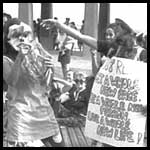 |
| . |
Holding child, pots and pans, she mops the boardwalk. |
|
|
|
| . |
The Revlon Lady tells her to put on a mask. "Be a whole
new person" and "get a whole new life." |
|
|
| |
 |
|
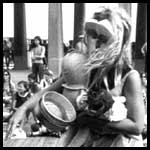 |
| . |
New Person; new mask; same choices. |
|
|
|
| . |
Nothing changes. It's just more of the same. |
|
|
|
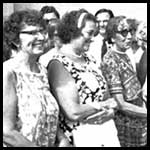 |
|
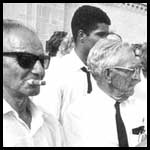 |
Spectators respond to the skit. |
| |
|
|
 |
| |
| |
|
|






